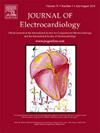Vectorcardiogram signal compression: A hybrid approach using discrete wavelet transform and singular vector sparse reconstruction
IF 1.3
4区 医学
Q3 CARDIAC & CARDIOVASCULAR SYSTEMS
引用次数: 0
Abstract
Aims
Vectorcardiography (VCG) records the heart's electrical activity in three dimensions: frontal, transverse, and sagittal for accurate cardiac diagnosis and monitoring. Continuous cardiac monitoring generates vast VCG data daily. The large amount of VCG data poses challenges for storage, dataset management, and transmission, particularly in remote areas with limited resources. The main objective of this research is to develop an efficient VCG data compression technique to streamline the handling and storage of cardiac data, reducing storage space, bandwidth use, and enhancing data transmission speed.
Methods
This work proposes a VCG data compression technique combining Discrete Wavelet Transform (DWT) and Singular Vector Sparse Reconstruction (SVSR) to reduce data size, while preserving vital cardiac information. The process consists of two stages: compression and reconstruction. In compression, the VCG signal undergoes decomposition using the Discrete Wavelet Transform with Haar wavelet, extracting low and high-frequency components. Moreover, the compression efficiency is enhanced by applying SVSR in each subband. In the reconstruction phase, the compressed VCG signal is restored by performing interpolation and the inverse discrete wavelet transform (IDWT), improving overall reconstruction performance.
Results
The results have been tested using PTB diagnostic ECG databases. The effectiveness of the developed compression method is examined quantitatively and qualitatively, in terms of the following metrics; such as compression ratio, signal-to-noise ratio, peak signal-to-noise ratio, percent root mean square difference (PRD) and structural similarity index. According to the performance metrics results, the proposed method achieves 55.67 % higher CR, and 57.12 % improved PRD as compared to existing method.
Conclusions
The proposed method is efficient and adaptable for compressing different VCG signals, offering control over the quality of reconstructed data. Simulated results illustrate that the proposed compression method is a very promising solution for data storage and tele-transmission applications.

矢量心电图信号压缩:一种使用离散小波变换和奇异向量稀疏重建的混合方法
超声心动图(VCG)记录心脏的电活动在三个维度:额、横、矢状,以准确的心脏诊断和监测。连续的心脏监测每天产生大量的VCG数据。大量的VCG数据给存储、数据集管理和传输带来了挑战,特别是在资源有限的偏远地区。本研究的主要目的是开发一种有效的VCG数据压缩技术,以简化心脏数据的处理和存储,减少存储空间,带宽使用,提高数据传输速度。方法提出一种结合离散小波变换(DWT)和奇异向量稀疏重构(SVSR)的VCG数据压缩技术,在保留心脏重要信息的同时减小数据量。这个过程包括两个阶段:压缩和重建。在压缩过程中,对VCG信号进行离散小波变换和Haar小波分解,提取低频和高频分量。此外,通过在每个子带中应用SVSR来提高压缩效率。在重建阶段,通过插值和逆离散小波变换(IDWT)对压缩后的VCG信号进行恢复,提高了整体重建性能。结果采用PTB诊断心电图数据库对结果进行了验证。开发的压缩方法的有效性进行了定量和定性检查,根据以下指标;如压缩比、信噪比、峰值信噪比、百分均方根差(PRD)和结构相似性指数。根据性能指标结果,与现有方法相比,该方法的CR提高了55.67%,PRD提高了57.12%。结论该方法对不同的VCG信号具有较好的压缩效率和适应性,可对重构数据的质量进行控制。仿真结果表明,所提出的压缩方法在数据存储和远程传输应用中是一种很有前途的解决方案。
本文章由计算机程序翻译,如有差异,请以英文原文为准。
求助全文
约1分钟内获得全文
求助全文
来源期刊

Journal of electrocardiology
医学-心血管系统
CiteScore
2.70
自引率
7.70%
发文量
152
审稿时长
38 days
期刊介绍:
The Journal of Electrocardiology is devoted exclusively to clinical and experimental studies of the electrical activities of the heart. It seeks to contribute significantly to the accuracy of diagnosis and prognosis and the effective treatment, prevention, or delay of heart disease. Editorial contents include electrocardiography, vectorcardiography, arrhythmias, membrane action potential, cardiac pacing, monitoring defibrillation, instrumentation, drug effects, and computer applications.
 求助内容:
求助内容: 应助结果提醒方式:
应助结果提醒方式:


